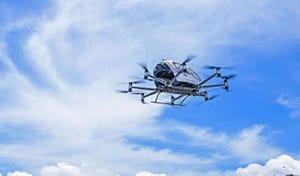French Concept Car Takes Connected Collaboration to a New Level
The car also exists as a digital twin, making it possible to simulate and test updates

A French consortium made up of six major companies has unveiled a tech-laden concept car that vividly demonstrates how connectivity will shape the future of mobility.
Software République was founded in 2021 and comprises automaker the Renault Group, telecoms giant Orange, semiconductor maker STMicroelectronics, electrical systems developer Thales and computing firms Atos and Dassault.
And the fruit of their labors was officially unveiled at the Viva Tech conference in Paris in the shape of the H1st Vision, a vehicle that heavily resembles Renault’s Scenic Vision SUV concept shown in 2022. H1st is said to stand for Human First. However, the real significance of the H1st Vision is not how it looks, but what it stands for, how it was developed and the technology it showcases.
According to Software République, the consortium aims to create “an open innovation ecosystem for sustainable, sovereign and safe mobility” and has the ambition of offering services from more than 50 start-ups in more than 50 markets by 2025. The H1st is a demonstration of how this collaborative approach will work.
Although revealed as a physical vehicle, it also exists as a digital twin, meaning it was possible to design, simulate and test products and innovations within the ecosystem much more quickly than is the norm. As the H1st was being developed, all the partners involved were able to ‘talk’ with each other in the cloud in real time, sharing information.
It also enabled the six founding members of Software République to invite seven start-ups to contribute ideas and technologies to the car’s development.
Among the innovations this development process has led to are biometric unlocking, which removes the need for a key fob and allows entry via recognition of a driver’s physical characteristics. This data is encoded in a Digital ID Wallet which will simplify car rental or license checks.
There’s also tech on board which allows the H1st Vision to locate, book and pay for a parking space remotely. This also applies to charging stations, where vehicle-to-grid (V2G) compatibility means it can return electricity to the grid when required.
Safety is also considered, with sensors in the steering wheel and seat belt monitoring the driver’s heartbeat and breathing rate respectively. With their health data being regularly analyzed, a health professional or emergency services can be contacted should problems arise.
The condition of the car is also constantly monitored, with virtual sensors that use machine learning and AI complementing physical ones to keep an eye on key components such as the battery, brakes, gearbox and chassis.
Vehicle-to-everything (V2X) tech, meanwhile, connects the car to the surrounding mobility ecosystem, sending alerts to the driver when there is imminent danger.
“The H1st vision concept car is a connected, physical and virtual object that demonstrates both a robust method for collaboration between the partners and how the technologies of Dassault Systèmes, Orange, STMicroelectronics, Renault Group and Thales complement each other to build the mobility of the future,” said Eric Feunteun, chief operating officer at Software République.
About the Author
You May Also Like








